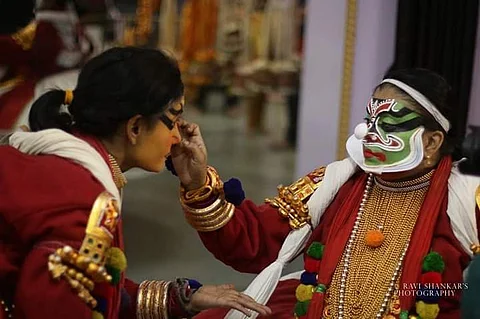

Believed to have originated between the 16th and 17th century, the history of Kathakali as an artform is interwoven with legends from the time. This dance of stunning colours and a range of instruments and oral renditions tells the most intricate stories through emotive eyes and stomping feet. Legend has it that when a performance of Krishnattom (an ancient temple art) was denied to a raja, he created Ramanattom in response by enacting stories from other Indian epics. Kathakali is believed to have evolved out of this.
Coming from the lands of rajas, Kathakali defied its origins and continued to be solely for the eyes of the 'high caste' and restricted to certain identities alone. But in 1975, a group of women broke one of the greatest taboos surrounding the artform by creating the first all-women Kathakali troupe in the state, the Thripunithura Vanitha Kathakali Sangham. The team — now headed by President Radhika Varma, a bank manager, and over 15 main members — continues to perform across temples and clubs in the state.
"It began in Thripunithara Kathakali Kendram when the secretary at the time, Rama Varma, suggested that an all-female katha could be performed," says Radhika, "We had a few women at the time. We arranged a very small show at the Kendram itself where one of us played the historic role of Hanuman and we got someone to play the chenda (drum). At the time, it was just meant to be for the amusement of those who were present."
But the group were surprised to find two bookings, one at a club and another at a temple, on the very same day. At the time, Kathakali had space for very few women, especially for major characters such as Bheem or Hanuman. Radhika, who has been performing Kathakali since the age of 9, says, "Before independence, Kathakali was performed only in major temples in the state and in the homes of well-established families. There were very few women and children who were a part of this at the time."
Once they started out, they were received warmly by most. Radhika explains, "We did not face any major backlash. There were a few people who would whisper behind our back but on the whole, we were able to go forward undeterred. Usually, women stopped learning Kathakali by class 8 or 9. People were surprised that I kept learning and performing even after getting married."
It was a decision by the Kerala government in 1967 that changed the scenario. The idea was to create schools under the Kerala Kalamandalam, the deemed-to-be University of Art and Culture, in order to conserve the artform before it died out in the culture. The poet, Vallathol Narayana Menon was inspired by Rabindranath Tagore to establish an institution to teach Kathakali in the state. And with this, Kathakali performances became more frequent and more people found a space for themselves within it.
Radhika says, "When we started out, women would only perform with other women. It was unimaginable for a male and female to perform together. Society has changed a lot since then, there's been so much progress in the past few decades. Now there are men who perform women's roles and women who perform men's roles. There are even female performers who perform great roles such as Ravanan in the mainstream!"
The troupe itself does not perform as much as it used to. Radhika says, "Our work is seasonal. When it is that time of the year, we perform continuously. We are often requested to perform in the same place multiple times. Many other all-female troupes have been formed since. All this has helped change the field immensely. It has reached a place where women cannot be ignored," she says. Over 60 women have performed with the troupe over the past years, the numbers and people varying according to the season.
Will Kathakali continue to be relevant? Radhika says, "It's relevance continues to grow. There was a time when male performers would be threatened if there were more than two of us in a performance. At a recent performance in Palakkad, more than 63 women performed in a rendering of the Sampoorna Ramayanam, one of the greatest kathas. Although the Kalamandalam still does not allow female students, there are four women studying there today. As long as it has room for such changes, the greatest mode of storytelling will be eternal."
